Kindy’s son Matthias is on a ketogenic diet and she has been looking for ways to make coconut oil tasty:
I am trying to add coconut oil in every place I can think of but this is harder to do than one would think. I want him to take 4 – 6 tablespoons a day so I can up his carbs a bit …
I am trying ‘hot chocolate’: heavy whipping cream, coconut oil, cocoa-plain, drop of stevia. He likes it but will only take a few drinks before he is ‘full’.
Others have also asked for ways to make coconut oil palatable – for instance, Ian.
A lot of Paleo dieters have recommended coconut bark. So we thought we’d give it a try.
Ingredients
We tried several different combinations of ingredients; all of them worked well. This seems a fairly fool-proof dessert.
The basic ingredients are:
1) coconut oil,
2) cocoa powder or chocolate,
3) nuts or nut butter, and
4) a carbohydrate.
We prefer low-omega-6 nuts, and low-fructose “safe starches” and sweeteners such as rice syrup or stevia. We do eat fruits and berries, but generally avoid any other sources of sucrose or fructose.
For our coconut bark experiments, we tried macadamia nuts and almond butter as our nuts, and puffed rice and figs as our carb sources. Here are a few of the ingredients we used — puffed rice, unsweetened cocoa powder, 72% chocolate, and almond butter:
For a more ketogenic (therapeutic) bark, increase the coconut oil and decrease the carbs; for a more dessert-like flavor, add more carbs.
OK, here’s what we did. I would characterize these as dessert-like and only mildly ketogenic.
Chocolate, macadamia nuts, almond butter, puffed rice
Ingredients for this version (we used rather more coconut oil than is shown here):
Preparation is very simple. First, mix the ingredients over a low heat. We melted the coconut oil first, then melted chocolate:
Then we mixed in the almond butter and ground macadamia nuts, followed by the puffed rice:
Next, pour the mixture onto a shallow aluminum-foil covered plate, and put in the refrigerator or freezer to cool. We put them in the refrigerator for ten minutes, then sliced the bark into pieces while it was still soft, and then moved it to the freezer for ten minutes to finish:
Chocolate, macadamia nuts, almond butter, figs, raisins, cocoa powder
This differed from the previous mix only in that diced figs and raisins replaced the puffed rice, and the finished bark pieces were dipped in cocoa powder. Ingredients:
Freshly poured onto the plate:
Cooled and sliced:
Served:
Conclusion
Coconut bark is not very nourishing, micronutrient-wise, but it is tasty and it does supply the ketogenic fats of coconut oil.
I suppose one could mix in ketogenic amino acids, like leucine or lysine, to make the bark even more ketogenic.
Ketogenic dieters shouldn’t suppose that they need to exclude all carbs. The body needs a little bit of glucose, and the bark will still be ketogenic if the coconut oil content is high enough.







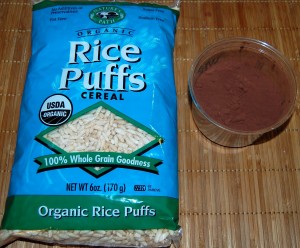
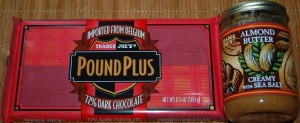
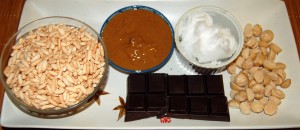
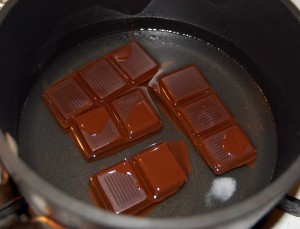
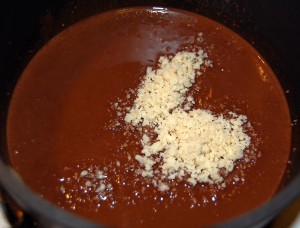
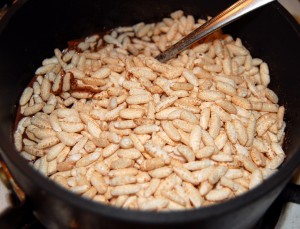
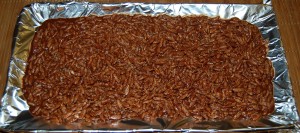

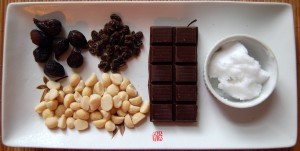
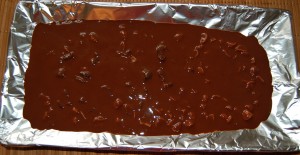
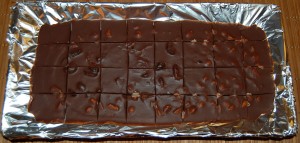





I make a version of this coconut bark. I use coconut oil, shredded coconut, 3 squares of 85% or higher dark chocolate, cocoa powder, and 2 or 3 scoops of whey protein mix. I like it and eat about 2 oz day. Incorporates a lot of coconut and takesaway any sugar/chocolate urges.
I will definitely try making some of this. Coconut oil by itself makes me gag.
Did you like that brand of puffed rice? I saw it in a 12pk on Amazon.com earlier today for like $14.
Hi Paul,
This stuff looks delicious. I’m thinking this might be a good food for bringing to track meets when our team is traveling.
Maybe this is outside of your scope, but while I’m at, what are your thoughts on competition day nutrition for maximizing performance like a 100m sprint and multiple jumping events throughout a day?
None of these events is particularly glycogen depleting, but it seems like having CHO available to the muscles would be advantageous. I also wonder what role coconut oil would play as a fuel for anaerobic activity.
Tyler
Extremely tempting stuff. Especially, as I like coconut oil straight from the box too. For the susceptible, this might awaken a dormant sweet tooth though.
Does any info exist (in general and AGEs in particular) of the changes created by high heat(?) industrial blowing up of rice?
I make something similar, using molasses.
2 tbsp unsulfered blackstrap molasses
2 tbsp coconut oil
2 TBLS tehina
chopped nuts (walnuts or pecans)
I melt VCO, mix in the tahina until smooth, then mix the BSM – again mix until smooth. Pour into a flat dish and refrigerate until hard. It could be good with some other nut butter. Molasses is apparently full of minerals, so I use it as a way to injest both the CO and the molasses.
A bit off topic…
I’ve been using a good quality CO. It works well for me in certain dishes, but not for others. I was using olive oil or butter for cooking on those occasions when the coconut oil didn’t taste right.
I just found, for the first time, a tasteless coconut oil which I can use anywhere. I know it isn’t as healthy as the stuff that does have a smell and a taste, but is it still good better to do my cooking in that as opposed to good quality olive oil?
Thanks!
Thanks, david!
Brandon – The puffed rice is fine. No sugar, that’s why we bought it. Very simple, plain rice.
Hi Tyler – Yes, you do want glycogen, but the glycogen filling should be done in the days before the event, not on the morning of events. In my view it’s best to compete relatively fasted – not much food in the ~3 hours before events besides water and electrolytes. Eat enough on competition day that there’s no hunger, but not to fullness. A banana would be a good pre-competition snack if one is needed. Eat mixed carbs/protein/fat breakfast. Coffee with starches helps refill glycogen.
Athletes could consider a bit of leucine powder the day of competition, possibly some coconut oil/MCTs pre-event (as ketones have high heat of combustion and heart works 20%+ more efficiently on them), but I’ll leave these kinds of optimizations for others to explore.
Hi donat,
Good question, I hadn’t really considered the possibility of toxins in puffed rice. I suspect the brown color is due to the use of brown rice, rather than due to AGEs, but I don’t know for sure. Since our brand used no sugar, there is not a strong reason for AGEs to form.
Thanks, melissa! There’s nothing wrong with using refined coconut oil. As far as I know they don’t introduce toxins, so nothing unhealthy about it.
Olive oil is great for cooking too, but it does have some omega-6s. Go with whichever tastes better, but if you want ketosis (or higher HDL), then coconut oil is needed.
Here’s a related idea from Tropical Traditions, using coconut cream (a form of whole coconut meat that is of course very rich in coconut oil). This recipe could be easily modified to eliminate the sugar, change the nuts, etc. Sounds good.
I find coconut cream delicious. Gary Taubes recently commented (in one of his Jimmy Moore interviews) that he has discovered this (he called it coconut butter I think) and couldn’t believe how good it is.
http://www.freecoconutrecipes.com/recipe_Better-Than-Candy_Nut_Crunchies.htm
I’ve been experimenting with ways to eat lots of coconut oil in line with Paul’s recommendations for migraine. I agree with Melissa that the taste and smell of VCO does not go with everything. Mostly I use Tropical Traditions expeller pressed coconut oil, which is steam deodorized and has no taste or smell. Since I have also been experimenting with adding 200 calories of safe starch back into my diet, I have discovered that a medium potato, grated like hash browns and fried in coconut oil, will soak up about 4 tablespoons. A similarly sized and prepared Japanese yam will soak up even more. If I saute every thing else I eat in coconut oil, and snack on some coconut cream, I’m easily up to 8 tablespoons. Have not yet managed 12!
I make a snack similar to these, almond clusters. Start with a cup of coconut oil, melted, then add 1/3 cup cocoa powder and a tsp of Vanilla. I add the equivalent of 1/4 to 1/2 cup sweetener (I use EZ-Sweetz liquid sucralose, 14 to 18 drops).
Using parchment paper on a cookie sheet, I arrange several almonds or peanuts in about 15 groups, then spoon a little more than a teaspoon of the coconut bark mixture (still melted) over them. I freeze these, but the refrigerator would work as well.
Because of the low melting point of coconut oil, these should be kept frozen or refrigerated. They melt in your hands easily. I would imagine they would be an absolute mess with a child.
Paul, did the mixture with unsweetened chocolate have less tendency to melt in your hands?
Not to be crass, but why not use butter and Rice Krispies?
Hi Frank,
Yes, forgot to mention that. These will melt in your hands, so you have to eat them cold.
I don’t know the best way to make them solid at room temperature, would welcome suggestions. This was our first try.
Hi Robert,
Butter is fine, but less ketogenic than coconut oil. Rice Krispies are usable, but these puffs have no sugar (an advantage, if we want sweet we’d rather add either fructose-free sources or fruits or berries which at least are real food) and are very cheap.
So if all you want is a dessert, butter and Rice Krispies are OK. But for stuffing NBIA kids with coconut oil, this is better.
@Paul; ah, got it. Missed the first line of the post and thus the context….
Have you thought about Mysorepak but with coconut oil rather than ghee?
Hi Robert,
That’s an excellent idea, but we’d probably want to substitute rice or potato flour for chick pea flour … and the coconut oil would still bring the melting problem.
Kate’s finding that potato and sweet potato really soak up the oil – which I’ve noticed from making mashed potatoes – suggests they may be particularly good for this dish.
mysorepak with oil is just a bit greasy. Sugar is the bigger problem, you’d need a lot of it and that would get you back into problems.
I was in the store today looking at rice syrup, and i noticed that the nutritional info seemed to vary somewhat between brands. One brand had 6g protein per 100g, while others had 1.1g protein. Also one said it contained 96g carb per 100g, while another had around 76 :/ (which makes more sense considering the water content). But I’m more confused about the variation in protein content …how much does yours have paul?
Also, slightly off topic, but i recently discovered that rice syrup + creme fraiche (put in the freezer for a bit to get really cold) + vanilla extract = deliciousness. Just like the vanilla icecream and caramel sauce i used to eat as a kid
Made the first recipe today with normal rice krispies (not much sugar so I don’t sweat it) and some brown rice syrup. Left it in the pot and threw that with a spoon in the fridge. Gonna take some self control to make it last, thanks for the recipe/idea!
Hi Remo,
Ours lists 0g protein, which for grain products is what we prefer. That’s in 36 g carbohydrate.
Thanks for the recipe!
This is similar to what I’ve been making lately. In Australia they’re called Chocolate Crackles and are a typical birthday party treat for children. Traditionally they’re made with Rice Krispies (we call them Rice Bubbles) and ‘Copha’ which is semi?- hydrogenated (solid) coconut oil (yuck) and that’s what helps them stay solid at room temperature.
I make mine with plain unsweetened puffed rice (toasted in the oven for 5-10 minutes to crisp up), shredded/flaked coconut, cocoa powder, 85% cocoa dark chocolate, coconut oil and some sweetener. I spoon the mixture into little foil baking cups so you can eat them without getting your fingers too greasy. They still have to be kept in the fridge though.
http://flic.kr/p/9mmihG
http://flic.kr/p/9midzr
Coconut oil does come in a convenient form. Try coconut chips, they contain 88% coconut oil. I buy from Wilderness Family Naturals in 30-lb bags. When I have my ocassional greek yogurt, I mix coconut flakes into it.
I also emulsify coconut oil in eggs when I make omeletes and use coconut milk in place of half-and-half.
About puffed rice / rice cakes and toxicity:
————————————————-
As for the process of making cereals which are shaped like little O’s, crowns, moons and the like… The machine used for making shaped cereals, called an extruder, is a huge pump with a die at one end… The slurry (of grains) goes into the extruder, is heated to a very high temperature and pushed through the die at high pressure. A spinning blade slices off each littel crown or elephant, which is carried on a stream of hot air past nozzles which spray a coating of oil and/or sugar on each piece to seal off the cereal from the ravages of milk and give it crunch. This extrusion process destroys much of the nutrient content of the ingredients, even the artificial chemical vitamins (enriched). The amino acid lysine, a crucial nutrient, is especially ravaged by extrusion. Yet the only changes made in the dozens of variables in the extrusion process are those which will cut costs… regardless of how these changes will alter the nutritive value of the product.
-Paul Sitt – Fighting the Food Giants
————————————————-
Whole grains that have been processed by high heat and pressure (extrusion process) to produce puffed-wheat, oats and rice (typical cold cereals – organic or not) are actually quite toxic and have caused rapid death in test animals. Rice cakes are absolutely horrid. Breakfast cereals have been slurried and extruded at high temperatures and pressures to make little flakes and shapes should also be avoided. Most, if not all, nutrients are destroyed during processing, and they are very difficult to digest. Studies show that these “extruded” whole grain preparations (rice cakes, typical cereals, granola) can have even more adverse effects on the blood sugar than refined sugar and white flour! The process leaves phytic acid intact but destroys phytase, a natural enzyme that breaks down some of the phytic acid in the digestive tract. It also causes fragile oils to become rancid and renders certain proteins toxic.
-Sally Fallon – Nourishing Traditions
—————————————————
Some breakfast cereals are toxic in and of themselves. These are the products made with puffed grains. Typical are puffed wheat, rice and millet. The problem stems from the method of manufacturing these products. These grains are subjected to high pressures and super-heated steam. When the pressure is quickly released, the steam exits the grain and puffs it.
Unfortunately, the high pressures and temperatures alter the molecular structure of protein molecules in the grains and render them toxic. These products are so toxic that feeding them to experimental animals will kill the animals after only a couple of weeks. In fact, animals eating puffed grains die sooner than feeding them no food at all! Beyond breakfast cereals, products such as rice cakes, which are made from puffed rice, are often sold in health food stores as a healthy snack!
-Raymond Francis – Never be sick again
—————————————————-
What about steel cut oats, Irish/Scottish oats made from oat groats, in terms of toxicity? I assume crackers have the same problem as cereal.
So I wonder if rice pasta is ok to eat then? I just had some mac & cheese yesterday made with rice pasta. Do you think it’s also toxic due to how it’s manufactured?
Clood. Say it ain’t so about rice cakes.
Two of them spread with Brie are about as decadent as I’m getting these days (except, of course, for two dark chocolate covered almonds).
Hi Clood,
I have a hard time believing this, but I’ll look into when I get time. I would bet that the toxins only appear if sugar and chemicals are added before high heat processing. It would be nice to see something from PubMed. Then I can look up what vague phrases like “more adverse effects on blood sugar than refined sugar” means. If you define adverse as higher peak blood sugar levels, any starch can produce a bigger peak per calorie than sucrose, because the fructose in sucrose doesn’t go to the blood. But the spike is transient and not harmful.
I should say we do recommend minimally processed rice products, such as the plain puffed rice we used in this recipe. They more processing goes on, the more chance toxins are introduced. A good rule is – if it looks natural, it’s probably better.
But high heat on natural rice makes it better, not worse, since toxins are destroyed. So unless your product has a lot of chemicals on the label, I wouldn’t worry.
Best, Paul
Hey Paul !
I was wondering if you could post the amounts of chocolate/macadamia nuts/almond butter/figs/raisins/ cocoa powder/puffed rice used in both desserts ?
I would like to duplicate your way first before experimenting and I find if I have the measurements, the whole thing goes a lot smoother 😉
Thank you in advance,
Debra
Hi Debra,
We don’t usually measure ingredients – we just go by eye – but the pictures are an excellent starting point. Using the proportions shown will give a bark that is neither hard nor soft.
For coconut bark there’s a really broad range of all the ingredients that will work, so you can’t go wrong. What changes is the texture and melting point – how hard it is when refrigerated, or how rapidly it softens at room temperature.
I personally thought this one was a little too sweet, so I would use less 72% chocolate and more unsweetened cocoa powder. More chocolate or cocoa makes the bark harder / more solid.
Nuts and nut butter contribute an intermediate level of hardness. Coconut oil makes it softer. Dried fruits can be used to make it sweeter.
Just experiment. Don’t worry, it will work!
Best, Paul
Paul and Shou-Ching, first off – I’m reading your book, and it is 100% thumbs up! Can’t wait to get deeper into it.
Anyways, I noticed you don’t have http://www.tropicaltraditions.com or http://www.freecoconutrecipes.com on your blogroll, and thought you might not be aware of its existance – they have so many (mostly PHD-friendly) ideas and recipes.
I have yet to try coconut bark, but I just ate a portion of coconut icecream 😉
Thank you for your hard work and fantastic book and blog!
Hi Rikke,
Glad you like the book!
We’ll check out their content. We may have to make a new blogroll category for food suppliers.
Best, Paul
is coconut milk allowed during ketogenic fasts? I drink it with my coffee. Cream makes my sinuses stuff up. In a 1/4 cup it has 1g carb and 1g protein and 11 g fat
The coconut milk does seem similar to the heavy cream, which has 1g carb 1/2 g protein and 11g fat in a 1/4 cup.
Hi Trina,
Yes, coconut milk is even better than cream.
Hi Paul,
I’m a little unclear on sugar. In seeking the perfect health diet balance in, let’s say, this coconut bark recipe, why not skip the rice and use sweeter chocolate (more sugar)? I understand the body needs *some* glucose and that is the reason for eating the safe starches.
Does sugar have inherent toxicity beyond the glycemic index issues of consuming it alone?
Many thanks,
Karen
Hi Karen,
We recommend getting fructose only from natural foods such as fruits, berries, and sugary vegetables (eg beets, onions, carrots, squashes, etc). On our diet you might eat 1 lb per day of those. Eating added sugar products might raise the fructose dose to damaging levels. Using sugary chocolate is OK if it’s not to sugary, ie >70% chocolate, but when adding sweeteners to baked goods or coconut bark I would use rice syrup rather than sucrose (which has fructose).
I’m going to blog about fructose soon so maybe that will explain a bit more.
Hi Paul,
Thanks a million for your response. I look forward to reading your fructose blog.
I didn’t realize sugar had fructose in it.
I am going to experiment with making something balanced for my candy craving son. He didn’t like the bark as I made it because it was not sweet enough for him (I used 85% dark chocolate and no extra sweetener). I may skip the puffed rice and add rice syrup.
Thanks again,
Karen
Where do you guys get your puffed rice from? I can only find brown puffed rice and I was hoping to find white puffed rice. LOVE the recipe, though! Amazing!! We’ve made it three times and put A LOT of coconut flakes in it 🙂
Hi Teresa,
Ours was whole (brown) rice too. Perfection is not always possible!
I just noticed you don’t seem too concerned with commenters using regular Rice Krispies, only a little about the extra sugar. In Canada they use malted barley so it has gluten. Is it just because it would be such a small amount that you’re not worried?
Hi Samantha,
Well, the sugar is bad, the barley is bad, and the puffing is bad (high-temperature dry environment can form toxins like acrylamide). I think as breakfast cereals go, unsugared puffed rice is not terrible, but it is not something I would recommend. I don’t worry so much about desserts because the quantity people eat is usually not large.
Dear Paul,
do you think the coconut bark would be a good way to get the required amount of coconut oil intake for those who cant stomach the cocnut oil by itself. My idea was to leave the rice crispies out and add some haselnut-, almond flour (just beause ist sits on my shelf and would add some volume)and Stevia to sweeten. Im not sure if nut flour is suitable scince it has about 24% of carbs? I was hoping it could be eaten during the intermitted fasting period to satisfy the cravings and supply the oil?
I also wanted to ask for your advice on the following: Scince scince last February I have been on the PHD and was feeling really god. unfortunately my skin condition didnt improve as i was hoping for (it tends to break out and takes ages to heal, I also have dandruff), but i guess i was a bit impatient too. During the last two month I started to crave conventional sweets, especiallly during depressive phases. I thought that this is more a psychological thing, but had the idea to try a ketogenic diet to see how this would respond to my mood (scince you mentioned this could be linked to an infection of the brain), skin condition and sugar cravings. Would be grateful to hear your take on that.
Thank you
Oh dear – excuse all the spelling mistakes.
Hi Paul,
A very random question: In a very dark room with your eyes fully adjusted, if you scrape the surface of room temp coconut oil – the coconut oil lights up a bit. Do you know what mechanism causes this?
Thanks for a superb book – the best health book I have read to date.
To get my son to eat more coconut oil, I put it in with his whey protein along with some extra stevia and vanilla (for taste) and whip it well so that it is all combined.
even a 70% chocolate bar has a lot of sugar in it doesn’t it? Have you calculated the sugar content of this recipe? Why not use more cocoa powder and more stevia to sweeten it instead and also more coconut oil to replace the cocoa butter in the chocolate bar?